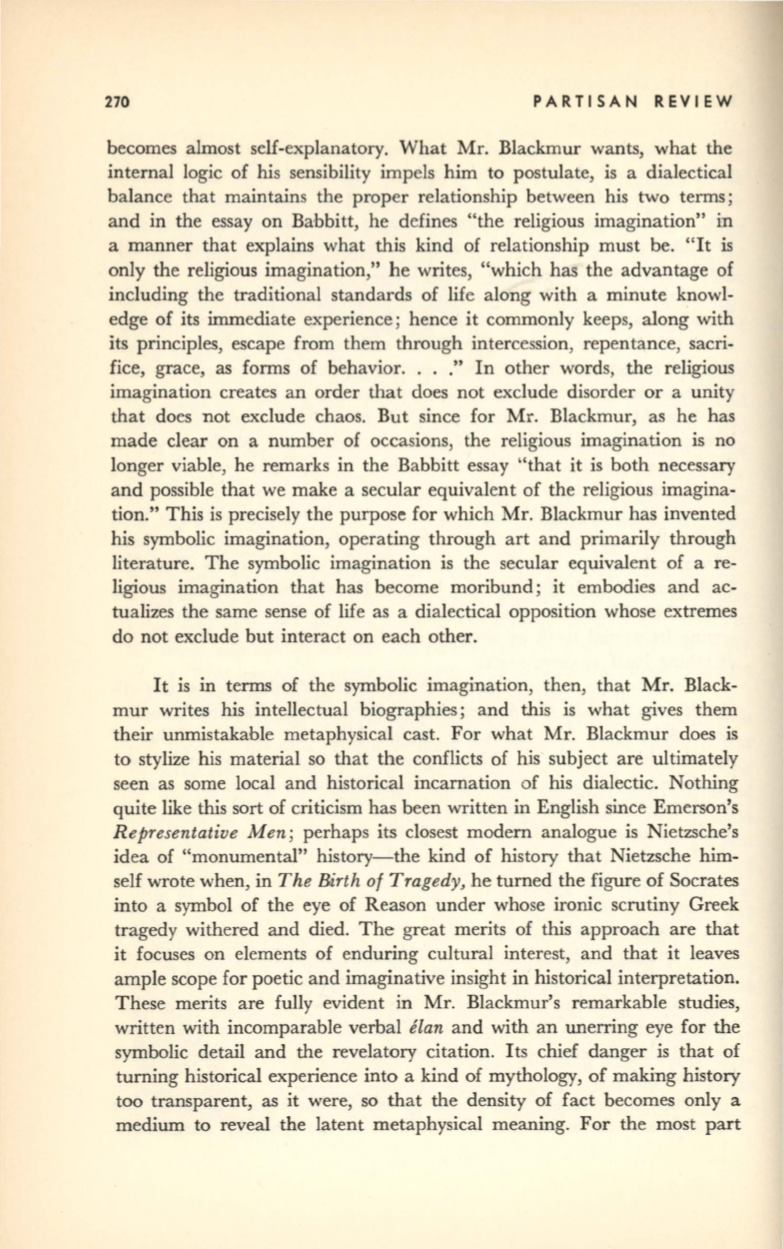
270
PARTISAN REVIEW
becomes almost self-explanatory. What Mr. Blackmur wants, what the
internal logic of his sensibility impels him to postulate, is a dialectical
balance that maintains the proper relationship between his two terms;
and in the essay on Babbitt, he defines "the religious imagination" in
a manner that explains what this kind of relationship must be. "It
is
only the religious imagination," he writes, "which has the advantage of
including the traditional standards of life along with a minute knowl–
edge of its immediate experience; hence it commonly keeps, along with
its principles, escape from them through intercession, repentance, sacri–
fice, grace, as forms of behavior...." In other words, the religious
imagination creates an order that does not exclude disorder or a unity
that does not exclude chaos. But since for Mr. Blackmur, as he has
made clear on a number of occasions, the religious imagination is no
longer viable, he remarks in the Babbitt essay "that it is both necessary
and possible that we make a secular equivalent of the religious imagina–
tion." This is precisely the purpose for which Mr. Blackmur has invented
his symbolic imagination, operating through art and primarily through
literature. The symbolic imagination is the secular equivalent of a re–
ligious imagination that has become moribund; it embodies and ac–
tualizes the same sense of life as a dialectical opposition whose extremes
do not exclude but interact on each other.
It is in terms of the symbolic imagination, then, that Mr. Black–
mur writes his intellectual biographies; and this is what gives them
their unmistakable metaphysical cast. For what Mr. Blackmur does is
to stylize his material so that the conflicts of his subject are ultimately
seen as some local and historical incarnation of his dialectic. Nothing
quite like this sort of criticism has been written in English since Emerson's
Representative Men;
perhaps its closest modern analogue is Nietzsche's
idea of "monumental" history-the kind of history that Nietzsche
him–
self wrote when, in
The Birth of Tragedy,
he turned the figure of Socrates
into a symbol of the eye of Reason under whose ironic scrutiny Greek
tragedy withered and died. The great merits of this approach are that
it focuses on elements of enduring cultural interest, and that it leaves
ample scope for poetic and imaginative insight in historical interpretation.
These merits are fully evident in Mr. Blackmur's remarkable studies,
written with incomparable verbal
elan
and with an unerring eye for the
symbolic detail and the revelatory citation. Its chief danger is that of
turning historical experience into a kind of mythology, of making history
too transparent, as it were, so that the density of fact becomes only a
medium to reveal the latent metaphysical meaning. For the most part


